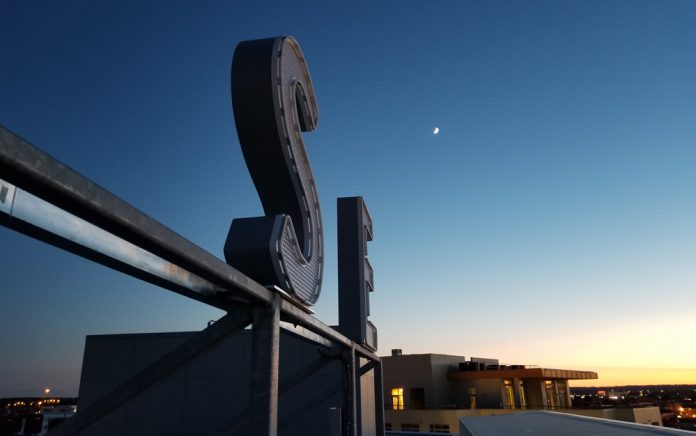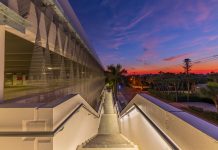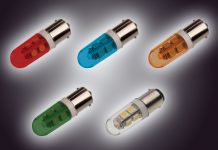 The Baltimore Harbor got a little brighter thanks to a new set of color-changing channel letters on the rooftop of Anthem House, a luxury apartment building in downtown Baltimore’s Locust Point neighborhood.
The Baltimore Harbor got a little brighter thanks to a new set of color-changing channel letters on the rooftop of Anthem House, a luxury apartment building in downtown Baltimore’s Locust Point neighborhood.
To bring their vision to life, Bozzuto Development (the management company for Anthem House) with Yount Design Inc., brought on Triangle Sign & Service (trianglesign.com), a Baltimore, Maryland full-service sign company that specializes in custom retail and architectural signs with fabrication, installation, and service capabilities.
“We have an existing relationship with the ownership, building management, and design team and had recommendations from all three groups to utilize our services on the project,” says David Shapiro, director of Business Development at Triangle Sign.
Yount Design had a clear vision of what they wanted the rooftop channel letters to look like—and do. “The original inspiration they gave us was a video where they had superimposed a twinkling star effect in the letters, and they asked if we could make the letters do something similar,” explains Shapiro.
Triangle Sign searched for an LED manufacturer that could make the twinkling effect happen, and they chose Everylite. “They were the only ones that we were able to identify that had electrical engineering in-house and the ability to program the DMX-controlled modules in-house,” says Shapiro. “Everylite was able to take that video the designer had first set up of the twinkle effect and program the controller to do that. Then they asked if the client wanted the American flag on there for July Fourth, and they programmed the American flag.
“They were able to give us not only the preloaded programs but then uniquely adjust the programming of that controller to give my client exactly what they wanted. The sign has over one hundred pre-programmed designs to run, and each module is addressed differently for each of those designs.”
Everylite’s Spectrum Series DMX LED modules were used inside of the channel letters. Everylite Smart iFlex, which serves as an LED alternative to neon lighting systems, was used as border tubing around the edge of each letter. “In the letters, it’s a DMX control signal, however, the border tube is a DMX converting out to an SPI signal,” explains Shapiro. “A master controller located inside the building controls all the lighting elements from one central file.”
With the lighting chosen, Triangle Sign worked on building samples for Anthem House from conceptual design files that were sent over. They used a combination of CorelDRAW and SAi Enroute software to design and build the samples.
“We worked back and forth with the building designer on this project submitting working samples for review,” says Shapiro. “Somewhere along the line, the designer came up with the idea of using a perforated metal face.
“The way that perforation sits, it isolates the light coming out and really made the display ‘pop.’”
When the final design was approved, Triangle Sign immediately got to work on fabrication, as there was a tight deadline. However a few challenges set the shop back a bit.
For one, the LED lighting had to be manufactured in China, but factories were closed for two weeks because of the Chinese New Year.
“On this particular application, there was so much border tubing that I wanted them to seal everything at the factory in China rather than seal it in the United States,” says Shapiro. “Your failure rate is only like a one percent difference, but when you have that many pieces, it’s significant.”
In addition to delays on the lighting, an engineering change in the middle of the fabrication required Triangle Sign to go back and make changes to the letters.
“The sign hovers above a raised portion of the roof, and due to the shape of the roof, the wind is really intense at that spot overlooking the harbor. The engineers significantly upgraded the requirements for the structural supports once we were already in production,” explains Shapiro.
Triangle Sign had to stop what they were doing to fabricate the “beefier” supports the engineers called for by welding one-half-inch-thick-by-twelve-inch-wide steel match plates onto the bottoms of the letters.
The letters, which spell out “Anthem House,” measure six feet-by-three inches tall and are one-foot deep.
The letter cans are made out of aluminum. Because the letters are so thick, they were formed by hand using letter breaks.
The perforated metal faces were cut on a MultiCam 5000 series router. Cut Lexan faces were inserted underneath the perforated metal to help diffuse the light and make it pop more. All the metal surfaces of the letters were finished with a gray AkzoNobel paint.
Overall fabrication took about three-and-a-half months, with Triangle Sign keeping the client updated on delivery times throughout.
One would think with a high-flying installation like this one that bringing the letters up to the rooftop would be the hardest part of the installation, but that wasn’t the case.
Triangle Sign lifted the letters to the rooftop using its 110-foot Manitex crane without a problem. “We had a great pivot point on one side of the building,” explains Shapiro. “We hoisted at that one side of the building, and then we walked each letter individually across the roof.
“Then we hoisted a couple of lifts up to the top of the building and used those to help stage the letters at each location while we were doing our drilling and fastening. Most of the install was done with hand tools and a magnetic drill press.”
The letters were mounted via match plates to an eight-foot-tall steel structural support that is directly imbedded into the building structure. The steel was so thick that the drill bit could only get halfway through on one side, so the install team ended up having to drill the steel from both sides.
In total, the actual hoisting and setting of the letters took about a week.
Where the real challenge came into play though was the wiring and programming of the letters.
For one, Triangle Sign had originally specified for the controller to be located in a control room directly beneath the sign. “However by the time we got up there to do the installation, the general contractor had already filled that room with other components for the building—the power box, air conditioning controls, etc.,” says Shapiro. “So the only place we could find room to put the controller was four-hundred feet away.”
A lot more wire was required to reach this new location, and at this point, everything was closed in on the building. The conduit to reach the other room was very small at only two-and-a-half inches.
 “The wiring we used was a little different than typical sign lighting wire—this was geared especially for the lighting controls—and the wire was thick,” says Shapiro. “We barely had enough room after we bundled all those wires together to get it through the conduit. It was an intense pull.”
“The wiring we used was a little different than typical sign lighting wire—this was geared especially for the lighting controls—and the wire was thick,” says Shapiro. “We barely had enough room after we bundled all those wires together to get it through the conduit. It was an intense pull.”
In working in coordination with the construction schedule on wiring to the control room and working with the management team to teach them how to control the sign, Triangle Sign was on site every day for about a month.
In the end, the sign company hurtled over all the challenges, and Anthem House now has a unique set of channel letters that does much more than twinkle over the Baltimore harbor.
View videos of the letters’ effects.
By Ashley Bray
All photos: Triangle Sign and Service.











